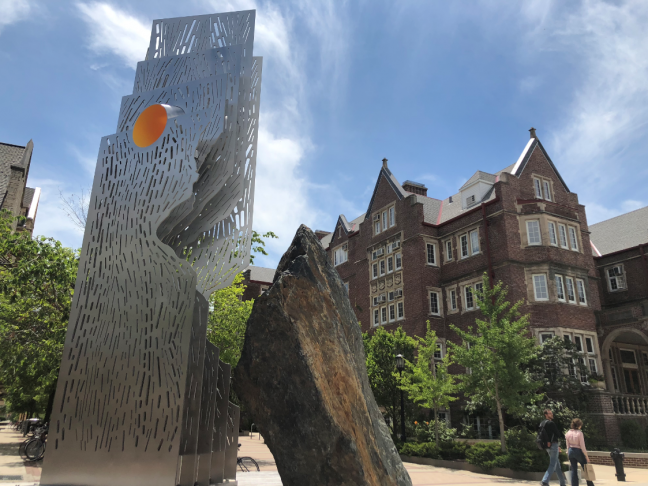This past June, the city of Madison welcomed artist team David Dahlquist and Matt Niebuhr and their newest piece of public artwork, the “Both/And – Tolerance/Innovation” sculpture in the 700/800 block of State Street with a dedication ceremony. The installation is located at the intersection of State Street, East Campus Mall and Library Mall, which is essentially where the city of Madison meets the University of Wisconsin campus.
But the sculpture’s story does not begin in June with the installation and physical representation of the artists’ work, it begins nearly three years ago.
Where the new sculpture now stands is once where another artist had his project footing planted. After years of nothing erected in that space, Madison Arts Program Administrator Karin Wolf and the Madison Arts Commission offered up the space through an application and competitive selection process. The biggest requirement was that the piece and its concept would need to be site specific.
“We did not want the piece to detract from the surrounding area but rather add to the beauty of the site,” Wolf said.
Nearly three years ago Niebuhr and Dahlquist, of RDG Dahlquist Art Studio (located in Des Moines, Iowa), applied for their space. According to Wolf, approximately 70 artists applied to create a piece for the space.
From beating out other artists to win the commission to meeting with and gaining approval with engineers about their drawings, to developing the concept for the piece after visiting the site, to having Karin Wolf, Madison Arts Program Administrator, jumping through hoops to make sure this piece gets finalized and dedicated, the process was nothing short of rigorous.
“The whole thing was an act of faith,” Dahlquist said. “You go in with an idea, and you want to achieve the spirit from A to Z.”
One of the most important aspects of the process for Niebuhr and Dahlquist was understanding the site. They developed their concept for the piece after observing and photographing from different vantage points at the site.
Niebuhr and Dahlquist observed a constant flow of people in this space with the backdrop of the alumni center, a library, a church, a mall and a lot of history. They described the space as a confluence.
“A confluence is where two rivers come together, and there is always going to be turbulence when water comes together, and it always ripples before it smooths out,” Dahlquist said. “In this case, it is a confluence of people in the space going in different directions to work, class and elsewhere.”
By extension, there is a confluence of ideas in this space.
“The space is naturally diverse, the people walking the space at given moment may have something in common in that moment,” Niebuhr and Dahlquist said.
This is a metaphor for tolerance, innovation and thought — to take the mental leap of conjoining those things in that space. This explains the “Tolerance/Innovation” part of the sculpture’s title.
The artist team explained that the “Both/And” aspect of the title comes from this type of logic, a logic that stands opposite to either/or logic.
“If you accept this both/and logic you accept abstract thinking, and this is where a lot of knowledge is born,” Dahlquist said.
Dahlquist is a UW alum and he recalled the famous documentary “The War at Home” which detailed the famous protests at UW’s campus during the Vietnam War. He explained how this spot and the campus, in general, has always been one of differing ideas and subject matter.
Like a lot of artists, Niebuhr and Dahlquist look for ways to welcome people into the story of their piece with different layers of interpretation. They want this piece to have a sense of mystery, for people to dig deeper into it and have a sense of wonder to connect their own dots.
Dahlquist has always welcomed diversity on campus since he was a student playing chess with kids from Somalia and Mississippi, and he and Niebuhr hope this piece serves to welcome people from all sorts of different backgrounds.
“We have potential to unite people on campus — if we want to explore diversity here, we can,” Dahlquist said.
Part of the sculpture is even made with a large indigenous stone that the artist team found in northern Wisconsin. The team thought it perfect as the stone hails from the Ho-Chunk natives, who did more for these Madison grounds than many people care to notice.
“[The Ho-Chunk] have an interesting sense of touch that grounds the spirit of the land,” Niebuhr and Dahlquist said.
Wolf explained how going beyond site-specific requirements, Niebuhr and Dahlquist appealed to the diverse Madison Arts Commission and the Downtown Coordinating Committee, in part, because of their thoughtful and inclusive concept.
“With a campus and community that is disproportionately non-Hispanic White it is not just a matter of recruiting people who are not White, but of having a campus environment that helps people succeed and want to stay,” Pam Oliver, UW sociology professor said.
Among other things, Niebuhr and Dahlquist hope this piece helps achieve that kind of environment.


